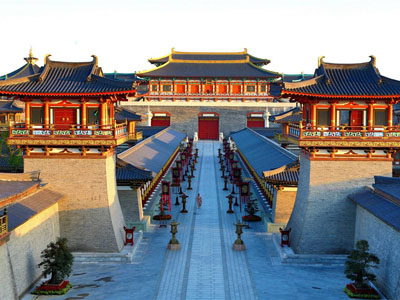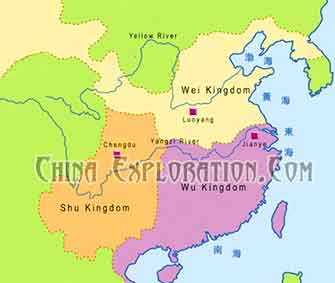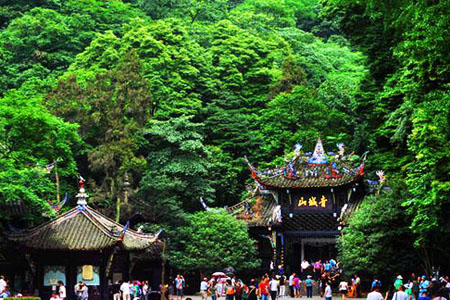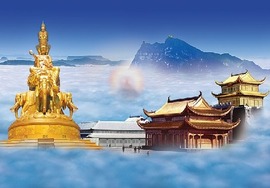It is overland tour to Mt. Wudangshan in Hubei province from Xian. Hubei province is located in mid China connecting many provinces in China by convenient transportation of railway, cruise, and flights......

About Three Kingdoms
The Three Kingdoms (AD 220–280), one of the bloodiest in Chinese history, a tripartite between the states of Wei, Shu, and Wu, followed the loss of the de facto power of the Han dynasty in China, ushering in the start of the Period of Disunity. To further distinguish the three states from other historical Chinese states of the same name, historians have added a relevant character: Wei is also known as Cao Wei, Shu is also known as Shu Han, and Wu is also known as Eastern Wu. The term "Three Kingdoms" itself is something of a mistranslation, since each state was eventually headed not by a king, but by an emperor who claimed legitimate succession from the Han dynasty. Nevertheless, the term "Three Kingdoms" has become standard among sinologists.
Technology advanced significantly during this period. Shu chancellor Zhuge Liang invented the wooden ox, suggested to be an early form of the wheelbarrow, and improved on the repeating crossbow. Wei mechanical engineer Ma Jun is considered by many to be the equal of his predecessor Zhang Heng. He invented a hydraulic-powered, mechanical puppet theatre designed for Emperor Ming of Wei, square-pallet chain pumps for irrigation of gardens in Luoyang, and the ingenious design of the south-pointing chariot, a non-magnetic directional compass operated by differential gears.
Although relatively short, this historical period has been greatly romanticized in the cultures of China, Japan, Korea, and Vietnam. It has been celebrated and popularized in operas, folk stories, novels and in more recent times, films, television, and video games. The best known of these is Luo Guanzhong's Romance of the Three Kingdoms, a Ming dynasty historical novel based on events in the Three Kingdoms period. The authoritative historical record of the era is Chen Shou's Records of the Three Kingdoms, along with Pei Songzhi's later annotations of the text.
More information about the three states:
 1. Shu, or Shu Han.
1. Shu, or Shu Han.
In 223, Liu Shan rose to the throne of Shu following his father's defeat and death. From 224 to 225, during his southward campaigns, Zhuge Liang conquered the southern territories up to Lake Dian in Yunnan.
In 227, Zhuge Liang transferred his main Shu armies to Hanzhong, and opened up the battle for the northwest with Wei. The next year, he ordered Zhao Yun to attack from Ji Gorge as a diversion while Zhuge himself led the main force to Mount Qi. The vanguard Ma Su, however, suffered a tactical defeat at Jieting and the Shu army was forced to withdraw. In the next six years Zhuge Liang attempted several more offensives, but supply problems limited the capacity for success. In 234 he led his last great northern offensive, reaching the Battle of Wuzhang Plains south of the Wei River. Due to the death of Zhuge Liang (234), however, the Shu army was forced once again to withdraw, but were pursued by Wei. The Shu forces began to withdraw; Sima Yi deduced Zhuge Liang's demise and ordered an attack. Shu struck back almost immediately, causing Sima Yi to second guess and allow Shu to withdraw successfully.
2. Wu, or Eastern Wu
Sun Quan turned to the aborigines of the southeast, whom the Chinese collectively called the "Shanyue". A collection of successes against the rebellious tribesmen culminated in the victory of 224. In that year Zhuge Ke ended a three-year siege of Danyang with the surrender of 100,000 Shanyue. Of these, 40,000 were drafted as auxiliaries into the Wu army. Meanwhile Shu was also experiencing troubles with the indigenous tribes of their south. The southwestern Nanman peoples rose in revolt against Shu authority, captured and looted cities in Yi Province. Zhuge Liang, recognizing the importance of stability in the south, ordered the advance of the Shu armies in three columns against the Nanman. He fought a number of engagements against the chieftain Meng Huo, at the end of which Meng Huo submitted. A tribesman was allowed to reside at the Shu capital Chengdu as an official and the Nanman formed their own battalions within the Shu army.
In the times of Zhuge Liang's northern offensives, the state of Wu had always been on the defensive against invasions from the north. The area around Hefei was the scene of many bitter battles and under constant pressure from Wei after the Battle of Red Cliffs. Warfare had grown so intense that many of the residents chose to migrate and resettle south of the Yangtze River. After Zhuge Liang's death, attacks on the southern Huai River region intensified but nonetheless, Wei could not break through the line of the river defenses erected by Wu, which included the Ruxu fortress.
Sun Quan's long reign is regarded as a time of plenty for his southern state. Migrations from the north and the settlement of the Shanyue increased manpower for agriculture, especially along the lower reaches of the Yangtze and in Kuaiji commandery (present-day Shaoxing). River transport blossomed, with the construction of the Zhedong and Jiangnan canals. Trade with Shu flourished, with a huge influx of Shu cotton and the development of celadon and metal industries. Ocean transport was improved to such an extent that sea journeys were made to Manchuria and the island of Taiwan. In the south, Wu merchants reached Linyi (Southern Vietnam) and Funan Kingdom. As the economy prospered, so too did the arts and culture. In the Yangtze delta, the first Buddhist influences reached the south from Luoyang.
3. Wei, or Cao Wei
In 226, Cao Pi died (aged 40) and was succeeded by his eldest son Cao Rui (aged 22).Minister Chen Qun, General Cao Zhen, General Cao Xiu, and General Sima Yi were appointed as regents, even though Cao Rui was able to manage the government in practice. However, eventually the former three died, leaving only Sima Yi as the senior minister and military commander. In 226, Sima Yi successfully defended Xiangyang against an offensive from Wu; this battle was the first time he had command in the field. In 227, Sima Yi was appointed to a post at Chang'an where he managed the military affairs along the Han River.
In 238, Sima Yi was dispatched to command a military campaign against Gongsun Yuan of Manchuria, resulting in Sima Yi's capture of his capital Xiangping and massacre of his government.[43] Between 244 and 245, General Guanqiu Jian was dispatched to invade Goguryeo and severely devastated that state. The northeastern frontier of Wei was now secured from any possible threats.
In 238, Cao Rui perished at age 35. He was succeeded by his adopted son Cao Fang (aged 7), who was a close member of the imperial family. Cao Rui had appointed Cao Shuang and Sima Yi to be Cao Fang's regents, even though he had contemplated to establish a regency council dominated by imperial family members. Cao Shuang held the principal control over the court. Meanwhile, Sima Yi was received the honorific title of Grand Tutor, but had virtually no influence at the court.
Three Kingdom Culture Relics
Sichuan is the political, military and cultural center of ancient Shu country in the era of Three Kingdoms. Abundant Shuhan Dynasty ruins exist widely in the province and they are so famous that not only the people within the country but in the whole world know them. So the famous ruins of Northwest and North Sichuan compose a unique and rare golder traveling route.
Chegndu Wuhou Shrine (Wuhou Temple) was first built in the late of West Jin Dynasty and it joined with Zhaolie Temple in the early of Ming Dynasty the existing Shrine was rebuilt at the eleventh year of Kangxi in Qing Dynasty (1672). In the Shrine there are old sky-scraping cypresses and plenty of antiques, which reflect the important story of Zhugeliang's life.
Deyang locates 71 kilometers away from Chengdu and in Northeast of it, there are Shuangzhong Shrine and Pangtong Tomb.
Mianyang's historical status is very important and its ancient name was Fu City. It is always called 'Key to Jianmen' and 'Throat of Shu Way'. Ruins in this area are Fule Mountain, Jiangwan Tomb and etc.
Zitong was a shire in Shu Dynasty, which ruled 5 counties. The Fu Army in this area is the main part of Shu Army. Primary ruins are: 'Zhuge Village', Yuma Gang, Tangjiao Stone and Zhangfei Cypresses.
Jianmen Gate is very steep and it's dominating battlefield looted by Shu and Wei country in the late of Three Kingdoms Dynasty. Three are such ruins as Jiangwei Tomb, Jianggong Bridge and Jiangwei Temple. Ancient Zhaohua Town was the most important, which was always looted by many countries from a long time ago. It was called Jiameng Gate. Many famous battles in Three Kingdoms Dynasty happened here.
Old Road exists in Mingyue Gorge beside Jialingjiang River; It's grand and dangerous. In the years when Zhugeliang battled in North he extended it. Nowadays it is called Chinese Transportation Museum because many of them interleaving in the gorge.
Zhangfei Temple is located in the western part of Langzhong city. In the temple there are a tomb and 'Limaming' which was written by Zhangfei himself.
Nanchong's Wan Juan Pavilion is where Chenshou, the author of 'Three Kingdoms Story', read books and in the pavilion there are many Chenshou's original handwritings.
Three Kingdoms, this unusual history, is an extraordinary battle history lasting one hundred years, which fills Huaxia (Chinese) offspring with proud. In this period a lot of people with wisdom and hero emerged. It's also the essence and the best era of the Old Shu Dynasty culture so it has high reputation in the whole world. Visitors of Japan, Southeast of Asia, Hongkong and Macao yearn for it very much. so it's an important selling and hot point in our province, which can attract visitor from the world.
Related Tours
3 Days Three Kingdoms Tour in North Sichuan
Insight Cultural Exploration in Sichuan of Southwest China

It is overland tour to Mt. Wudangshan in Hubei province from Xian. Hubei province is located in mid China connecting many provinces in China by convenient transportation of railway, cruise, and flights......

One day classic tours of Chengdu to Mt. Qingchengshan and Dujiangyan Dam will show tourist the profound of ancient Chinese wisdom and culture in harmony relation with the world. ......

The most classic one day Chengdu tours will bring tourist to Chengdu Giant panda garden and Leshan giant buddha with private travel guide and car in Chengdu, extremely convenient and easy!......

One days best Chengdu tours bring tourist to Sanxingdui museum and giant panda garden with private guide and car, making your tour in Chengdu easy. ......
This panda volunteer work provide tourist with one days unique experience of Panda volunteer project works and bring them an intimate touch with Giant pandas, also the best way to learn deep about pand......

It is tour from the only one operator in Chengdu tours market offering Emeishan and Leshan tours by bullet train. Our highlights including Leshan Giant Buddha and Mt Emeishan. ......

